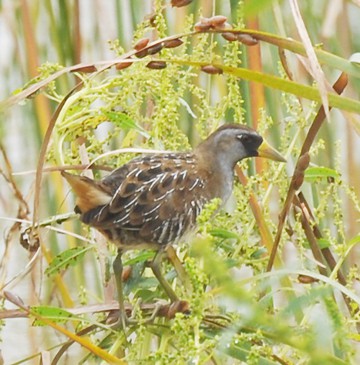This Week’s Creature Feature: Riding Out the Flood



The record-setting flood on the Patuxent River that shut down parts of Route 4 and Route 301 on September 8 also created chaos and danger for the animals living in Jug Bay marshes. Mattress-sized clumps of uprooted marsh plants and large logs floated fast downstream. The current in the river’s main channel was pumping three times faster than normal.
On the river’s edges, where wild rice and cattail stalks poked above the brown waters, the heads of red-bellied and eastern painted turtles popped up. Even for turtles, this was way too much water.
Overhead, huge flocks of red-winged blackbirds drifted. Normally, these birds would be stripping seeds from the stands of wild rice. With their marsh gone from sight, they seemed agitated. Laughing gulls were plentiful, ready to take a fish, a mouse or any easy-to-catch prey. Raptors were abundant, too: peregrine falcon, bald eagle, osprey, Cooper’s hawk, sharp-shinned hawk, northern harrier and red-shouldered hawk. The flood had exposed many types of prey that were now easy pickings for aerial predators.
Thousands of half-inch-long amber marsh snails clung to plant stalks just above the water. Semi-aquatic, these snails will drown if held underwater. The delicate brown snails were piled in clumps by the dozen, waiting for the waters to subside — or they became lunch for a blackbird or a gull.
Rice rats are small, cute, gray-brown rodents (not like a Norway rat) that live entirely in the marsh. About a dozen of these little fellows were found clinging to the few plants not submerged. They appeared shocked by the unprecedented high waters because we could paddle our kayaks to within a foot or two of them before they jumped in the water to swim to a safer perch.
Sora rails are secretive marsh birds that remain well hidden in thick vegetation. They are loath to appear in the open. So it was amazing when we saw 15 soras — more than a birder might see in a decade of marsh visits — looking bedraggled and nervous as they perched precariously on stalks of water hemp and rice. Some shared their roost with a rice rat nearly underfoot.
The mild-mannered aquatic queen snake is much less common than its larger cousin, the northern water snake. Queen snakes forage in the shallower marsh waters, feeding exclusively on freshly molted crayfish. We found three hanging from wild rice stalks. It might be many days before they can return to their normal haunts.
Even during this historic flood, wild animals remain resilient. Some individuals were certainly lost, but most will survive. The existence of these Patuxent wetlands, vibrant and fully protected, means that the endemic animals that depend on this habitat will find the means to hang on till the waters subside.
